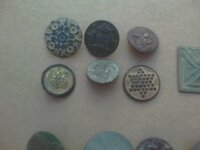M3Detectorist
Jr. Member
Hey all,
I found this button on an old farm site that was farmed in the 18th and 19th centuries. The button was reading about a copper/brass as well as gold on a Garrett AT Pro and steady on the gold reading on a Garrett GTI 2500 if that helps. In addition, I believe it is gold plated because the gold color that you see in the picture is even more vibrant in person and you can also see where it looks as though the gold has chipped away some. All I did to clean is mild soapy water. If anyone has any suggestions on how to clean better it would also be much appreciated. The button also measures 3/4 of an inch and is single looped. Pictures are posed below and if you have any questions feel free to ask!
Thanks for the help!






I found this button on an old farm site that was farmed in the 18th and 19th centuries. The button was reading about a copper/brass as well as gold on a Garrett AT Pro and steady on the gold reading on a Garrett GTI 2500 if that helps. In addition, I believe it is gold plated because the gold color that you see in the picture is even more vibrant in person and you can also see where it looks as though the gold has chipped away some. All I did to clean is mild soapy water. If anyone has any suggestions on how to clean better it would also be much appreciated. The button also measures 3/4 of an inch and is single looped. Pictures are posed below and if you have any questions feel free to ask!
Thanks for the help!










